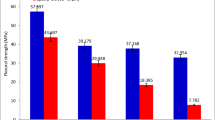Abstract
Magnetostrictive particles like Terfenol-D are investigated with respect to their ability to detect internal stress, generated in carbon fibre-reinforced polymers (CFRP) in a non-destructive way. The results are presented in two parts. The first part elucidates the ideas for the preparation of dispersions based on these particles with high density in epoxy resins. There is particular focus on the effects of particle size and concentration. Different particle sizes in a range of 0–300 μm are selected by special separation techniques. The particle size distribution is controlled in dry state by laser diffraction method. Changing of the chemical composition, particularly by the oxidation of particles, is analysed by EDX. Use of a magnetic field is identified as a suitable means for the stabilisation of these high-weighted particle fractions dispersed in epoxy resins. The particle size distribution, as well as the alignment of particles, in the cured epoxy resins is investigated by SEM and light microscopy. The second part of the study covers the magnetostrictive properties of the modified epoxy resins which are quantified by the detection of internal stress in CFRP.






Similar content being viewed by others
References
Rudd CD, Long AC, Kendall KN, Mangin CGE (1998) Liquid moulding technologies. Woodhead Publishing Limited, Cambridge
Kruckenberg TK, Paton R (1998) Resin transfer moulding for aerospace structures. Kluwer, Dordrecht
Kleineberg M, Nickel J, Pabsch A, Sigle C, Schöppinger C (2000) Equipment an method for production of fibre-reinforced composites and/or plastic components according to a modified RTM method. DE 198 53 709 C1
Jensen HM (2002) Acta Mater 50:2895
Coker EG, Filon LNG (1931) A treatise on photoelasticity. Cambridge University Press, Cambridge
Frocht MM (1941) Photoelasticity, vol 1 (1941), vol 2 (1948). Wiley, New York
Lloyd JM (1975) Thermal imaging systems. Springer. ISBN 9780306308482
Guzmán de Villoria R, Yamamoto N, Miravete A, Wardle BL (2011) Nanotechnology 22:185502
Ling HY, Lau KT, Cheng L, Su Z (2006) Compos Struct 76:88
Yashiro S, Okabe T, Takeda N (2007) Compos Sci Technol 67:286
Okabe Y, Yashiro S, Tsuji R, Mizutani T, Takeda N (2002) Compos Part A 33:991
Krautkraemer J, Krautkraemer H (1990) Ultrasonic testing of materials. Springer. ISBN 9783540512318
Wang X, Chung DDL (1998) Compos Interfaces 5:277
Böger L, Wichmann MH, Meyer LO, Schulte K (2008) Compos Sci Technol 68:1886
Schulte K, Baron Ch (1989) Compos Sci Technol 36:349
De la Vega A, Kovacs JZ, Bauhofer W, Schulte K (2009) Compos Sci Technol 69:1540
De la Vega A, Kinloch IA, Young RJ, Bauhofer W, Schulte K (2011) Compos Sci Technol 71:160
Kupke M, Schulte K, Schüler R (2001) Compos Sci Technol 61:837
Muto N, Arai Y, Shin SG, Matsubara H, Yanagida H, Sugita M et al (2001) Compos Sci Technol 61:875
Egusa S, Iwasawa N (1996) J Reinf Plast Compos 15:806
Zhang Y (2006) J Intell Mater Syst Struct 17:843
Krishnamurthy AV, Anjanappa M, Wang Z, Chen X (1999) J Intell Mater Syst Struct 10:825
Saidha E, Naik GN, Gopalkrishnan S (2003) Struct Health Monit 2:273
Giurgiutiu V, Jichi F, Berman JB, Kamphaus JM (2001) Smart Mater Struct 10:934
Schilde C, Nolte H, Arlt C, Kwade A (2010) Compos Sci Technol 70:657
Jiles DC (1995) J Phys D Appl Phys 28:1573
Lee EW (1955) Rep Prog Phys 18:184
Newnham RE (1986) Ferroelectrics 1:1
Skinner DP, Newnham RE, Cross LE (1978) Mater Res Bull 13:599
Acknowledgements
The authors wish to thank Mr. C. Schilde (Institute for Particle Technology, Technical University Braunschweig, Germany) for carrying out particle fractionations and detection of the particle size distributions.
Author information
Authors and Affiliations
Corresponding author
Rights and permissions
About this article
Cite this article
Kubicka, M., Mahrholz, T., Kühn, A. et al. Magnetostrictive properties of epoxy resins modified with Terfenol-D particles for detection of internal stress in CFRP. Part 1: Materials and processes. J Mater Sci 47, 5752–5759 (2012). https://doi.org/10.1007/s10853-012-6466-3
Received:
Accepted:
Published:
Issue Date:
DOI: https://doi.org/10.1007/s10853-012-6466-3




